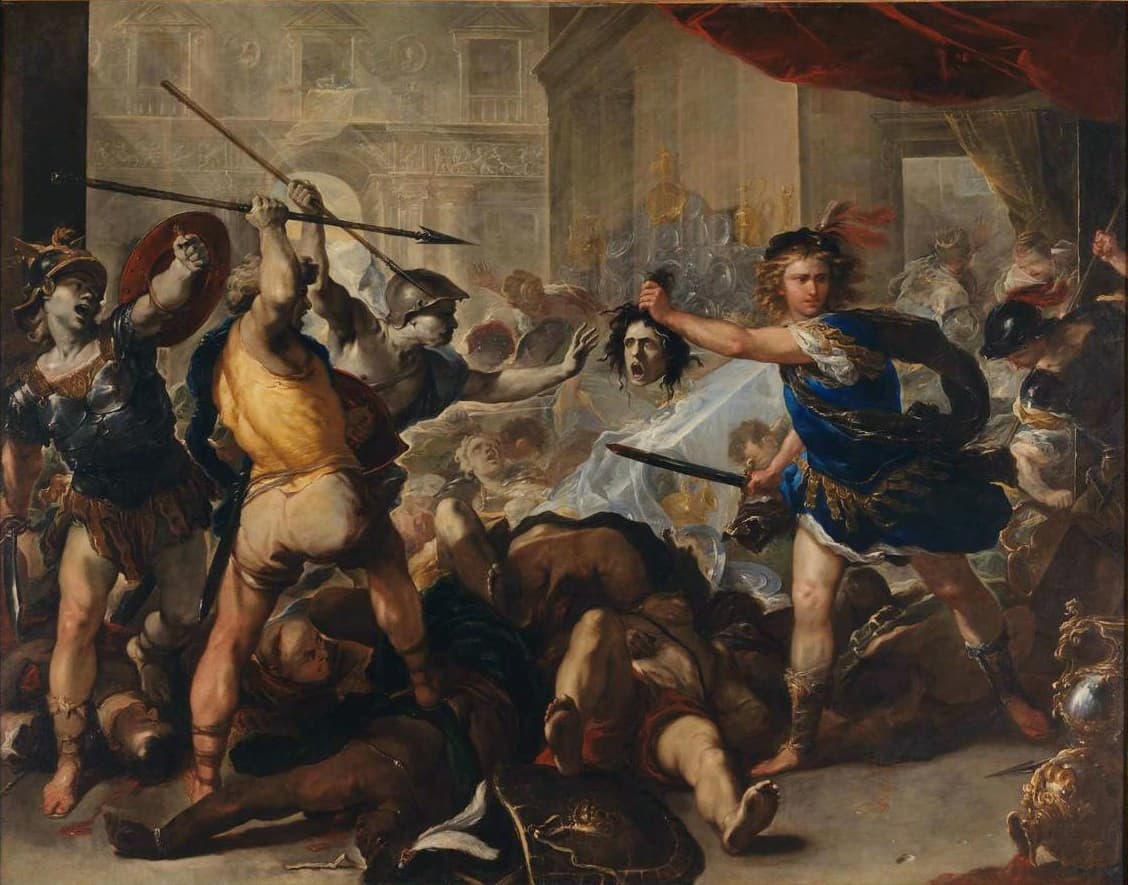In an earlier episode, I told the story that Carl Ditters von Dittersdorf (1739-1799) planned on writing a total of 15 symphonies based on Ovid’s Metamorphoses. He presented the Viennese publisher Artaria with a detailed outline of his grand design. Each work would have its own title page, a preface, in the form of a synopsis of the action, while each individual movement would be preceded by an engraving and a quotation, in the original Latin, from the relevant passage in the Metamorphoses.

Portrait of the composer Carl Ditters von Dittersdorf
The publisher Artaria wasn’t really all that interested, so the project was taken up some years later by his rival Torricella. He went ahead and published the first three symphonies immediately but without the projected engravings. But that was it, as the symphonies numbers 4 to 6 have survived only in manuscript, and the symphonies 7, 8, and 13 have recently been discovered in an arrangement for piano-four-hands fashioned by the composer. They are the only known versions of three of the symphonies from the second group of six.
The symphonies 8, 10, and 11 have been lost, and since the project wasn’t a particularly great commercial success, the last three symphonies 12, 14, and 15 were never composed. In the surviving symphonies, Dittersdorf sets out to tell fanciful stories through a series of musical tableaux the meanings of which are signalled by the accompanying literary tags. Some of these tableaux are static, they serve to set a scene or establish a character, but others are dynamic, through-composed action pieces that embody within them the moment of metamorphosis.
Carl Ditters von Dittersdorf: Symphony No. 5 in A Major, (Transformation of the Lycian Peasants into Frogs), “Allegretto” (Prague Chamber Orchestra; Bohumil Gregor, cond.)

Giulio Carpioni: Latona Turning the Lycian Peasants into Frogs
In his 5th Symphony, Dittersdorf musically paints a short tale from Greek mythology that centres around Leto, also known as Latona to the Romans. Taken from the sixth book of Ovid’s Metamorphoses, the transformation of Lycian peasants into frogs is scored for pairs of flutes, oboes, and horns, with strings. The story takes place inside the borders of Lycia, in a region of Asia Minor, with rough country people “gathering bushy osier, rushes, and the fine marsh sedges.”
In the opening jolly “Allegretto”, Dittersdorf provides a musical description of a simple farming life. A rustic dance with plenty of foot stomping gets things started and after a delightful modulation, the music sounds the serenity of the countryside with the hot sun shimmering in the violins overhead. The suspenseful development is short-lived, and the rustic dance returns with vigour.
Carl Ditters von Dittersdorf: Symphony No. 5 in A Major, (Transformation of the Lycian Peasants into Frogs), “Adagio ma non molto” (Prague Chamber Orchestra; Bohumil Gregor, cond.)
It just so happened, that the goddess Leto and her infants Artemis and Apollo, were passing through Lycia. As the fierce sun scorched the earth, and weary from her long journey the goddess felt very thirsty. By chance, she saw a smallish lake in a deep valley, and she put her knee to the ground, rested, and was hoping to enjoy a drink of cool water. However, a group of rustic peasants denied it to her.

Fountain of Latona
In the “Adagio” movement Dittersdorf presents a musical portrait of the goodness in conversation with the peasants begging for water. “Why do you forbid me your waters? The use of water is everyone’s right. I come for a public gift, and yet I beg you to grant it to me as a suppliant. I was not preparing to bathe my limbs and my weary body here, only to quench my thirst. A drink of water would be nectar to me, and I would bear witness to accepting life from it, as well: you will be giving life from your waves. Let these children move you, also, who stretch their little arms out from my breast.” But as you can hear in the music, the rough peasants reject her pleas forcefully.
Carl Ditters von Dittersdorf: Symphony No. 5 in A Major, (Transformation of the Lycian Peasants into Frogs), “Minuetto” (Prague Chamber Orchestra; Bohumil Gregor, cond.)
The peasants are clearly not moved by the goddess’ pleas. Ovid tells us “despite her prayers they presided in denying her with threats and added insults besides. Not content with that, they also stirred the pool with their hands and feet, and churned up the soft mud from the depths, by leaping about, maliciously.” As we can hear in the “Minuet,” the goddess, however, is becoming more agitated and her first sparks of anger are depicted in forceful string accents.
The concluding movement opens with an ominous “Adagio” as the goddess stretched her arms to the heavens and said, “Live in that swamp forever.” A fugal section starts the process of metamorphosis as the peasants are slowly transforming with their “voices getting hoarse, their inflated throats are swollen, and their croaking distends their wide mouths. Their backs are green, their bellies, the largest part of their body are white, and as newly made frogs, they leap and croak in their muddy pool.” Can you hear the pitiful croaking in the music?
Carl Ditters von Dittersdorf: Symphony No.6 in A Major, (Transformation of the Lycian Peasants into Frogs), “Finale” (Prague Chamber Orchestra; Bohumil Gregor, cond.)

Leto in the Wilderness
For his Sixth Symphony based on fanciful stories from Ovid’s Metamorphoses, Dittersdorf revisits the story of Perseus and Andromeda. Do you remember that Perseus had rescued Andromeda from the sea monster and fallen in love with her? Everybody agreed that they should get married. But now for the complication, Andromeda was already engaged to Phineus, and he is not ready to give up his bride willingly.
Dittersdorf scores this symphony for flute, pairs of oboes, horns, trumpets and timpani, and strings, with the timpani only used in the final movement. There is no inscription for the opening “Andante,” but most of the paintings of that period show preparations for a grand wedding. The music has a regal character, and a trumpet fanfare announces the arrival of the guests and the happy couple.
Carl Ditters von Dittersdorf: Symphony No.6 in D Major, (The turning to Stone of Phineus and his friends), “Andante” (Prague Chamber Orchestra; Bohumil Gregor, cond.)
The peaceful setting, however, is short-lived as Phineus and his supporters are crashing the party. The first scuffles erupt and Perseus kills Athis, who is mourned by the Assyrian Lycabas. He also attacks Perseus and is promptly killed. Next, Clytius and Clanis are slain by Perseus, and Dittersdorf provides a musical description of these initial clashes in a spirited “Allegro.” The music is highly agitated and the delicate counterpoint paints the tumultuous scene.
Carl Ditters von Dittersdorf: Symphony No.6 in D Major, (The turning to Stone of Phineus and his friends), “Allegro assai” (Prague Chamber Orchestra; Bohumil Gregor, cond.)

Sebastiano Ricci: Perseus Confronting Phineus with the Head of Medusa
In the slow movement, assigned to plucked strings we meet the musician hired to play the lyre for the wedding celebration. He is to celebrate the union with an improvised song and accompany himself with his cithara. The pair of oboes sing the praises of the couple, but in the end, the musician is killed by a companion of Phineus. Can you hear the lyre falling from his hands as he falls dead to the ground?
As Ovid tells us, “Phineus and a thousand followers of Phineus, surround the one man. Spears to the right of him, spears to the left of him fly thicker than winter hail, past his eyes and ears. He sets his back and shoulders against a massive stone column, and protected behind, turns towards the opposing crowd of men.”
Carl Ditters von Dittersdorf: Symphony No.6 in D Major, (The turning to Stone of Phineus and his friends), “Andante molto” (Prague Chamber Orchestra; Bohumil Gregor, cond.)
In danger of being overwhelmed, Perseus announced, “if there are any friends here, turn your face away,” and he held up Medusa’s head. In an instant, hundreds of warriors are turned to stone, and Phineus admits defeat. However, he is not spared but petrified for eternity. Ovid describes this scene, “as Phineus tried to avert his gaze, his neck hardened, and the tears on his cheeks were turned to stone. Now the frightened face, the suppliant expression, the submissive hands, and the slavish appearance, remained, in marble.”
In his music, Dittersdorf paints a wonderful picture of the ongoing battle, with the strokes of the timpani striking down the numerous enemies. But then the music slows and almost comes to a stop in a vivid musical description of everybody turning to stone. Dittersdorf can’t really end his symphony like that, so he ends the movement with a bright and cheerful wedding dance and a brass fanfare. In his fanciful stories in music, Dittersdorf ingeniously “invests these movements with dramatic significance rather than attempt to advance the narrative through musical action.”

Luca Giordano: Perseus turning Phineas and his Followers to Stone
Dittersdorf’s “Ovid Symphonies” are brilliantly conceived, and much of the fun is trying to figure out what is actually going on in the music. Whether he is setting a scene or telling an action-packed story, Dittersdorf’s fanciful musical tales will surely stimulate the imagination of every music lover.
For more of the best in classical music, sign up for our E-Newsletter
Carl Ditters von Dittersdorf: Symphony No. 5 in D Major, (The turning to Stone of Phineus and his friends), “Finale” (Prague Chamber Orchestra; Bohumil Gregor, cond.)
